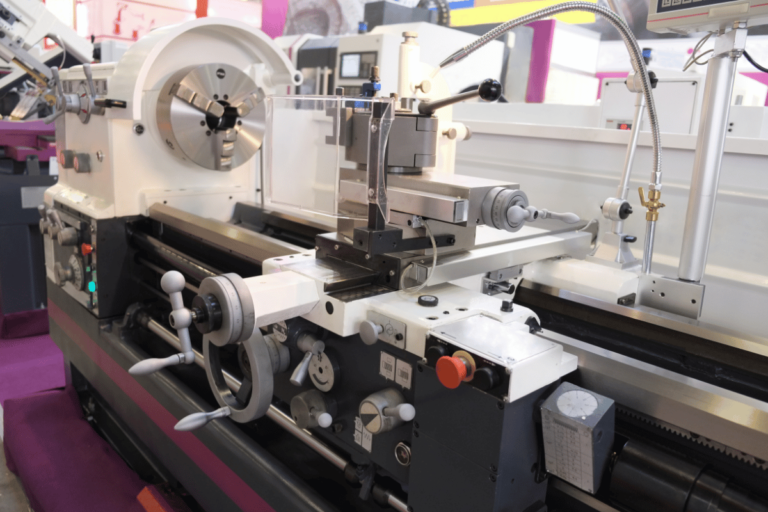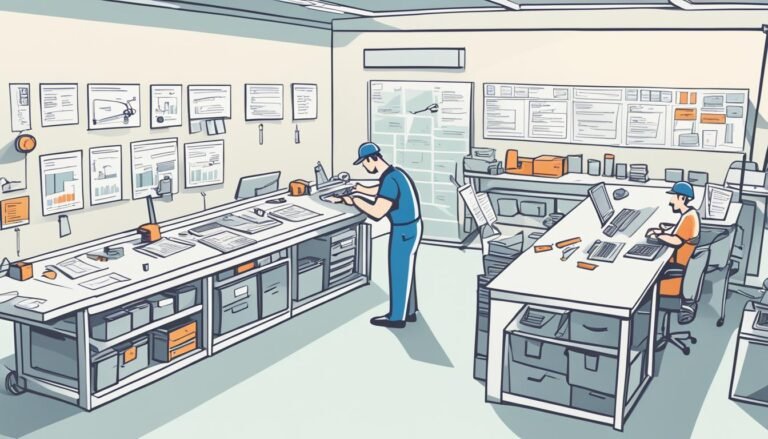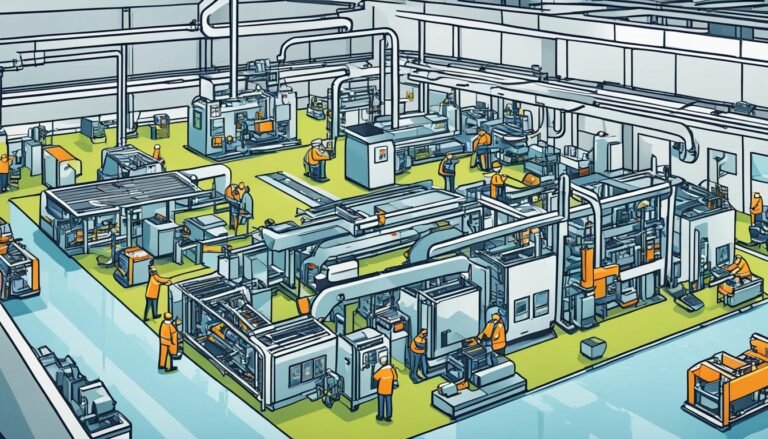Manufacturing Abbreviations: Industry Terms Explained
Did you know over 90% of manufacturing pros use shortened terms to talk faster and work better? These terms help with everything from money matters to keeping the workplace safe. This piece covers the key abbreviations you should know, like COGS (Cost of Goods Sold) and OSHA (Occupational Safety and Health Administration).
These terms make talking clearer and keep things precise and safe in manufacturing. They’re key for anyone working in the field.
Key Takeaways
- Abbreviations make talking in manufacturing faster and more efficient.
- Financial terms like COGS help understand costs.
- Safety terms such as OSHA keep the workplace safe.
- Abbreviations cover many areas, from money to tech.
- Knowing these terms is crucial for smooth operations.
Understanding the Basics of Manufacturing Abbreviations
Manufacturing abbreviations are key to making communication in factories run smoothly. They act as a quick way to share information among workers, managers, and executives. Terms like BOM and COO help professionals quickly talk about complex ideas without needing to explain them a lot.
Introduction to Common Manufacturing Terms
Terms like BOM (Bill of Materials) and COO (Cost of Ownership) are crucial every day. They make complicated details easier to understand, helping with planning and checking costs. Knowing these terms helps keep things clear and precise in making things.
Importance of Abbreviations in Manufacturing
Abbreviations are very important in manufacturing because they make communication clearer and cut down on mistakes. Using terms like JIT (Just-In-Time) and MRP (Material Requirements Planning) helps teams talk better, making sure everyone knows what to do. This leads to better teamwork and more efficient work.
| Abbreviation | Full Form | Application |
|---|---|---|
| BOM | Bill of Materials | Lists components needed for manufacturing a product |
| COO | Cost of Ownership | Estimates total expenditure of owning an asset |
| JIT | Just-In-Time | Inventory management strategy |
Learning factory shorthand and plant lingo is key for smooth operations. As the manufacturing world changes, so does the language used in it. So, understanding these abbreviations is more important than ever.
Common Financial Abbreviations in Manufacturing
In the world of manufacturing, many important financial terms help manage money and make things run smoothly. These terms are key for budgeting, tracking costs, and handling payments.
ABM: Activity-Based Management
Activity-Based Management (ABM) looks at what activities cost the most. It helps make better decisions by knowing the costs of each activity. This way, it helps plan better and use resources wisely.
ABM is important in manufacturing. It helps understand costs clearly, making sure money is used well.
AP: Accounts Payable and AR: Accounts Receivable
Accounts Payable (AP) and Accounts Receivable (AR) are key in manufacturing finance. AP is what the company owes for goods and services bought. AR is the money customers owe for what they bought.
Managing AP and AR well keeps a company liquid and running smoothly.
COGS: Cost of Goods Sold
Cost of Goods Sold (COGS) is the direct cost of making and selling products. It includes the cost of materials and labor. Knowing COGS is crucial in manufacturing.
It affects the gross profit and the financial health of the company. Calculating COGS right helps set the right prices, budget, and plan finances.
These financial terms are vital for the manufacturing industry. They show how important accurate financial management is.
Production and Operations Abbreviations
Production and operations in manufacturing rely on complex systems and methods. These are often shown through specific abbreviations. Knowing these terms can really help professionals in the field.
CAD: Computer-Aided Design
CAD, or Computer-Aided Design, is key in today’s manufacturing. It lets designers make precise designs for production. Using CAD makes the workflow smoother and ensures accuracy in making products.
Knowing CAD can make a big difference in product development and design.
JIT: Just-In-Time
Just-In-Time (JIT) is a big deal in production and operations. This inventory system is known for cutting waste and improving workflow. The idea is to order materials from suppliers just in time for production.
Understanding JIT can really improve logistics and operations management. It’s an important term for manufacturing pros.
Quality and Safety Control Abbreviations
Quality assurance terms and safety control jargon are key in manufacturing. Using abbreviations like FMEA, SPC, and OSHA helps streamline these important processes. These terms save time and make sure quality and safety are followed well.
FMEA: Failure Mode and Effects Analysis
FMEA stands for Failure Mode and Effects Analysis. It’s a strong method to find possible failures in a system. This term helps businesses avoid risks and make things more reliable. Using FMEA leads to smoother operations and fewer problems.
SPC: Statistical Process Control
SPC means Statistical Process Control. It uses statistical methods to watch and control production. By looking at data, SPC keeps product quality and consistency high. It’s a key term that makes sure products are made right, without too much variation.
OSHA: Occupational Safety and Health Administration
OSHA stands for Occupational Safety and Health Administration. It sets and checks workplace safety and health rules. OSHA’s rules are vital for keeping manufacturing safe. Following these rules shows a strong commitment to keeping workers safe, which is part of quality assurance.
Supply Chain and Logistics Abbreviations
In the fast-paced world of manufacturing, abbreviations for supply chain and logistics are key. They make communication faster and operations more efficient. Let’s explore important supply chain acronyms and logistics shorthand vital for understanding manufacturing workflows.
ERP: Enterprise Resource Planning
ERP stands for Enterprise Resource Planning. It’s essential in modern manufacturing. ERP systems bring together planning, purchasing, inventory, sales, and marketing. This integration reduces data duplication and improves decision-making.
By streamlining operations, ERP can cut costs and boost productivity.
SCM: Supply Chain Management
SCM, or Supply Chain Management, deals with managing the flow of goods and services. It covers all steps from raw materials to final products. Good SCM strategies are key to a smooth supply chain.
They ensure production, shipment, and delivery work together well. This means products get to customers on time, making them happy.
RFID: Radio-Frequency Identification
RFID uses electromagnetic fields to identify and track items automatically. In manufacturing, it boosts logistics and inventory management. It lets data be captured and stored wirelessly, making stock management more accurate and efficient.
ERP, SCM, and RFID are crucial for smooth and efficient manufacturing supply chains.
| Abbreviation | Full Form | Application |
|---|---|---|
| ERP | Enterprise Resource Planning | Integration of various operational facets |
| SCM | Supply Chain Management | Flow management of goods and services |
| RFID | Radio-Frequency Identification | Automatic identification and tracking |
Specialized Manufacturing Technologies Abbreviations
In today’s fast-changing world, specialized manufacturing technology terms and advanced production acronyms are key to making things run smoothly. Knowing these terms is a must for those in the industry and companies looking to improve their work flow.
AIDC: Automatic Identification and Data Capture
Automatic Identification and Data Capture (AIDC) systems are crucial in today’s manufacturing. They automatically identify items, gather data, and put this data into computers without needing a person to do it. This tech speeds up the process, makes data more accurate, and cuts down on mistakes. It’s a must-have in today’s manufacturing world.
PLC: Programmable Logic Controller
Programmable Logic Controllers (PLCs) are key to automating tasks in factories. They control machines on the assembly lines, making sure everything runs smoothly and efficiently. Using terms like PLC helps manufacturers work better and keep their work consistent.
| Abbreviation | Full Form | Function | Benefits |
|---|---|---|---|
| AIDC | Automatic Identification and Data Capture | Automatic data collection and entry | Improves accuracy, reduces errors |
| PLC | Programmable Logic Controller | Automation of industrial processes | Enhances precision, boosts productivity |
Common Manufacturing Abbreviations and Their Meanings
The manufacturing world is full of abbreviations and terms. It’s key to know these for anyone in production. We’ll look at three important abbreviations used in making things.
BOM: Bill of Materials
The Bill of Materials (BOM) lists all the parts needed to make a product. It’s a crucial document in production. It shows every raw material, sub-assembly, and part, with how much you need. Think of it as a guide for making things.
OEE: Overall Equipment Effectiveness
Overall Equipment Effectiveness (OEE) measures how well a manufacturing process works. It looks at equipment use, how well it performs, and the quality of the product. This helps manufacturers find ways to work better.
- Availability: How often the equipment is ready to work.
- Performance: How fast the equipment runs compared to its top speed.
- Quality: The number of good products made out of all started.
MTBF: Mean Time Between Failures
Mean Time Between Failures (MTBF) shows how reliable a machine is. It’s the average time between when it stops working and starts again. This info helps plan maintenance and understand equipment life, important in production.
Knowing these abbreviations helps manufacturers work better and more efficiently.
Conclusion
As we wrap up our look at manufacturing abbreviations, it’s clear they’re key to the industry’s success. Terms like ABM and COGS help with finance. CAD and JIT make production smoother.
Abbreviations for quality and safety, like FMEA and OSHA, show how important high standards are. Supply chain terms, including ERP and RFID, help manage inventory and resources well.
Knowing about specialized tech and core manufacturing terms, like OEE and MTBF, helps workers boost productivity and make equipment more reliable. This guide is more than just a list of terms. It helps decode industry speak, improve communication, and unite everyone in manufacturing.







